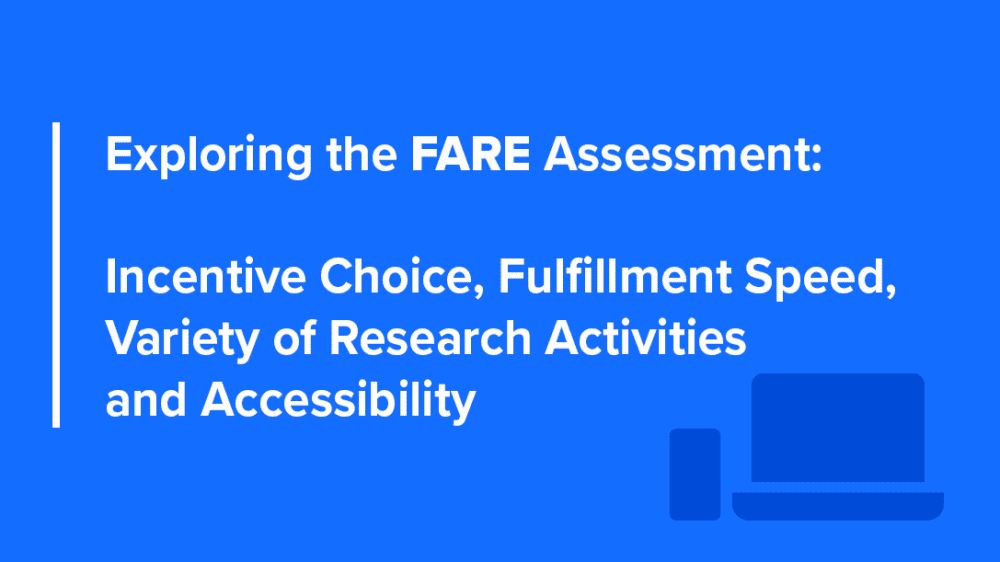Research participant engagement has hit a crisis point. Participants are checking out. Engagement has bhit a low point after years of declining compensation and repetitive surveys. Now, companies need higher quality responses than ever before, but many aren’t doing the right things to get them.
The FARE Framework includes twelve steps for evaluating research participant engagement. Four of these elements – incentive choice, fulfillment speed, research variety, and accessibility – play an especially crucial role in rebuilding relationships with research participants.
Let’s examine why these matter and how getting them right can transform research quality.
The problem with basic incentives
Many research companies think offering PayPal or Amazon rewards covers their bases. This bare minimum approach only works for about two-thirds of potential participants. The rest? They either decline to participate or drop out partway through.
Read more: Research Incentives 101: Setting Appropriate Compensation
Geography plays a bigger role than most realize. In the UK, participants readily share bank details for direct transfers. Try that approach in the US, and participants get nervous. They want different payment options. Yet many companies stick to one-size-fits-all rewards.
The stakes get even higher when research demands more effort.
Want someone to record a video showing how they make dinner? Share personal shopping habits? Think deeply about complex topics? The standard $2 Amazon gift card won’t cut it anymore. Companies need to match rewards to effort, or research participant engagement can plummet.
“The panels have been optimized for people who do quick and easy surveys. If you suddenly switch and expect these day laborers to do high-level thinking, you’re going to have problems. It’s not what the panels were designed to do,”
says Frank Kelly, Market Research Practice Lead at Virtual Incentives.
Why waiting for payment kills participant engagement
Picture this: You spend 30 minutes providing thoughtful feedback about your experiences with a product. The company promises you $10 for your time. Then, they make you wait four weeks to get paid. Sound frustrating? This happens constantly to research participants.
“Pretty much all of our incentives can be paid in real-time, certainly in less than an hour. Maybe a few countries might take a day,”
Frank explains. “I see a lot of companies say, ‘We’ll give it to you in two to four weeks.’ They’re delaying incentives, which is a shame because making people wait that long annoys them.”
Most rewards can be delivered within an hour. Some companies claim they need weeks to verify responses or manage cash flow. But this approach backfires. Participants who take time to share meaningful feedback want their reward while they still remember why they earned it. Making them wait breeds skepticism and erodes trust.
Quick payment does more than make people happy. It keeps research participant engagement high.
When participants know they’ll get paid promptly, they’re more likely to participate and provide quality responses. Yet many companies still need to prioritize payment speed.
No one wants to be stuck on a survey assembly line
Research participants hate feeling like they’re stuck on an assembly line, answering the same types of questions over and over. They engage more deeply when they have some control over their experience, much like choosing what to watch on TV rather than being stuck with whatever’s on.
Some research platforms automatically push participants from one identical survey to the next. Better ones show multiple options and let participants choose. While some researchers worry this creates bias, sharing basic details about length, payment, and general topics actually improves response quality.
The research world is changing. Traditional surveys might be cut in half within three years as new methods emerge. Smart research panels are already adapting, offering everything from ad reviews to discussion forums to mystery shopping. Participants want this variety, and panels that provide it see better retention and engagement.
Making research work for everyone isn’t optional anymore
About 20% of people worldwide have some form of disability. That’s too large a group to ignore.
But making research accessible means different things in different places. Some countries actively accommodate various disabilities, while others view disability through an entirely different cultural lens.
Basic technical requirements matter. Screen readers need to work, colors need proper contrast, and images need clear descriptions.
Accessibility becomes even more important as populations age. Most of us will eventually need larger text to read comfortably, have trouble distinguishing certain colors, or find small mobile buttons harder to tap accurately.
If research panels don’t account for these natural changes that come with aging, they’ll gradually exclude more and more experienced participants. Every participant who drops out because they can’t read tiny gray text on a white background represents a lost voice in the research.
Moving forward with better research participant engagement
The way we collect research data is undergoing a fundamental shift.
AI-driven interviews are replacing traditional surveys. Video responses and in-depth conversations are becoming standard. Discussion forums and mystery shopping add new layers of complexity. But all these advanced methods depend on one thing, participants who feel valued and respected enough to provide thoughtful, honest responses.
The FARE framework provides a structured way to evaluate participant engagement across multiple dimensions.
As research moves beyond simple surveys, understanding how to maintain strong research participant engagement through incentives, payment speed, varied activities, and accessible design is important for gathering meaningful insights.
